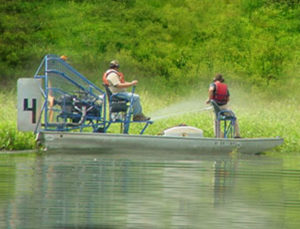
Lake and Pond Management Weed Control
Aquatic Vegetation Management is an important element to consider when developing a lake management program. If a body of water is overpopulated with nuisance vegetation, it fails to produce enjoyment, and never becomes the recreational resource it should be. Too many weeds make swimming and other recreational pursuits impossible; and fishing…..well, all you wind up reeling in is a headache.
The first step in proper aquatic vegetation management is plant identification. Knowing the plant is paramount when choosing a method of control. Chemical, biological, and mechanical methods are all useful when planning a control strategy for aquatic weeds.
Herbicidal control is one of the most efficient tools for controlling undesirable vegetation. Products approved by the E.P.A. can be applied in such a way as to provide selectivity, which means controlling certain species while leaving others. They may also be used to achieve total control of the vegetation. Of course this doesn’t mean eradication. Eradication, which is very seldom desired, is usually not healthy for an aquatic ecosystem. Generally speaking, herbicides are injected into the water column through a spray system attached to an airboat.
Biological methods utilize living herbivorous organisms to control the weeds. While the use of insects and pathogens is gaining wide spread acceptance, certainly the most often used organism for aquatic weed control is the grass carp (White Amur). This fish, which is a native of Russian and Chinese Rivers, has been successfully used for weed control in the U.S. for about four decades, and has proven to be an effective and inexpensive method.
Mechanical control usually means the use of cutters and harvesters. Basically, this is equivalent to mowing the grass in your yard. However, after the plants are cut, they may be loaded on to a conveyer belt, which then deposits the plant into a bin for later disposal or maceration. Macerated plant parts are rendered non-viable and may be reintroduced into the water as a nutrient source, if desired.
Fertilizing with associated liming is also used to effectively control aquatic vegetation. This technique is discussed in greater detail on a linked page in this website.